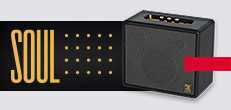PEOPLE WHO INSPIRE
“All our devices, which have been designed and developed from scratch, are manufactured entirely in-house.”
A conversation with David Fernández

In the fascinating universe where music and technology mix, a passionate lover of rock drummers and starry skies rises up. Their ability to translate technical complexity into understandable solutions demonstrates their commitment not only to innovation, but also to the satisfaction and understanding of all our customers.
David recommends…
- A book: I’m more of a classics guy. I still remember how 20000 Leagues Under the Sea put me inside the Nautilus. I think that book gave me the fantasy of having a boat in my retirement and going out to challenge the beasts of the high seas. I already have my Open Water Diver’s certificate. I’m missing the boat and the harpoon for hunting giant octopuses.
- A film:My childhood friends wouldn’t forgive me if I didn’t put here the film I gave them such a hard time about. I don’t know if he was my alter ego in my dreams, or if I really would have liked to be like him today. It won several anti-Oscars at the time, but for me it gave me dozens of hours of banter with colleagues and phrases that 30 years after I saw it for the first time, are still with me and in my way of life. That’s right, it’s The Adventures of Ford Fairlane. It’s so bad, it’s the best.
- A song:My weakside! Tricky, very tricky to choose one. My passion for music doesn’t allow me to classify these things. They are Rush and I will never be able to see them live anymore. Their drummer, Neil Peart, in my top list of most influential drummers, left us not long ago. What for me was the purest band in history and the ones who have made me experience so many emotions, will never again take to the stage. Their purity didn’t allow them to play if it wasn’t them, if it wasn’t that reformed trio back in ’74. It’s hard to choose just one, but with their song Subdivisions, the tribute this time is for those who have ever felt marginalised.

Hi David, tell us something about you…. What is your role at Fonestar?
Hi! I introduce myself as a lover of music, of the skies and of good-sounding sound.
I am an Electronics Technician and, for more than 13 years, I have been part of Fonestar’s R&D&I department, where I have designed numerous equipment related to sending audio over the data network, among others. My function in this department has been related to the world of hardware and has been, from the assembly of PCB prototypes, to the final assembly of the equipment, including its testing.
Although in that department we all have to keep an eye on the iteration of the teams with the rest of the environment, my role has been largely related to that of beta tester.
All our equipment is manufactured entirely in our facilities. And one of my functions, as an intermediary between R&D and the production department, is to establish the most agile and correct way to manufacture such equipment, also giving support to production when required.
On the other hand, I also take care of the repair of the electronic boards of our equipment.
I am part of the customer service department and provide technical assistance to customers who are on site and have questions about the equipment.

What do you like most about your job?
Without a doubt, seeing the things you do come out well. And by that I mean as far as I’m concerned in terms of setting up a prototype board for a team. It is sometimes a complex phase in which the slightest fault or faulty component can mean many hours of detection and testing. Seeing things work the first time is certainly the most gratifying thing. And, if not, finding the cause of a malfunction in the previous phases of prototyping is also a great satisfaction.
Another thing that gives me the jitters is when a client’s installation has become complicated with some relatively convoluted issue, sometimes network issues and sometimes poltergeist issues that sometimes make you pull your hair out and say… no way! But after a good dose of perseverance, the demon comes out, never to return.

Can you tell us about your experience in implementing and testing audio over IP solutions and how this technology is transforming the sound industry?
From my point of view, every customer I have dealt with has shown great interest and has taken our audio over IP solution as a breakthrough for their needs.
I came into this company fairly young, having installed PA with 100 volt lines on a few occasions prior to joining. When I came here, I didn’t know about this way of sending audio and it really blew my mind to see little by little how well our first audio stream player AIP-3010 ended up working. Years have passed and the market has already been gradually adopting IP-based audio systems as the main solutions. But back then it was unparalleled.

Audio over IP solutions are becoming increasingly popular. What are the common challenges you encounter when testing these technologies and how do you overcome them to ensure optimal performance?
The devices in the networks are becoming more and more complex. To give an example, several years ago the switches that were put in the premises used to be unmanaged. But for some time now, they have been managed more and more frequently and with more and more parameters to be controlled. In these cases, we sometimes encounter ” tripwires ” when one of these switches has disabled certain basic functions for the correct functioning of our equipment. These are things that didn’t happen with the “dumb” switches. It is therefore important from time to time to keep up to date on what types of equipment are available and, if necessary, to purchase and test them ourselves in the laboratory, as has been the case in a very recent case.

How do you work with other professionals and teams to perform end-to-end testing of audio over IP solutions and ensure interoperability?
And that’s how lucky I have been, to have the best people always by my side and to have all of them perfectly meshed so that the fluidity in the resolution of failures was total.
It has been a luxury that first versions of equipment were released and that a large part of the equipment functions went smoothly. But when this has not been the case, it has been enough for me to detect the error, tell a colleague or write it down in an incident chat, and usually in less than a day, to have it fixed and with a new equipment update uploaded for testing. I have to say that some cases have been complex and that sometimes detection has been most laborious and capricious. Those mistakes are daunting, but when they are found… you can imagine the adrenaline rush it gives! Hehehe

Customer service is key in any technical role. How do you make sure you understand your customers’ needs in terms of audio over IP and how do you translate their requirements into specific tests to ensure customer satisfaction?
Always start from the beginning. Who hasn’t been annoyed when calling the internet provider and the first thing they ask you is… do you have your router switched on?
In this case we did not get to that point by any means, but when it comes to IP-based equipment, there is a lot of infrastructure surrounding it and, in order to avoid any potential unpleasantness, it is advisable to ask the basic questions initially. Things like whether the equipment has a fixed or dynamic IP, whether they have a router that has a DHCP server enabled, or whether the equipment is separated by several switches, can give many clues that, if you save yourself the trouble of asking, you may have to spend a lot more time asking around. On the other hand, customers with more knowledge in these areas understand it perfectly and even appreciate it.
“Often you can’t apply everything that is new on the market to your equipment, as you would never finish developing the original solution.

Can you share an example of a complex technical problem you have solved when testing an audio over IP solution and how you addressed it?
Of course. I remember a case that kept me glued to the phone for quite some time. It so happens that once while talking to an installer who was in a school installing AIP equipment, something happened to him that neither of us could have imagined. On the one hand, he had tested the equipment in his laboratory before bringing it to the school. But once there, I plugged them into a switch and didn’t see them. First of all, after performing the typical checks and still not being able to see the computers in the application, the only thing left to do was to check whether the Windows firewall defended the TCP and UDP connections of the computers were allowed. As it was a public school PC, the administrator had blocked access to the firewall, so we had to try another PC. Once that was found to be the reason, the installer removed the switch where he had all the equipment connected and plugged the ethernet cable from that PC into one socket, and an AIP equipment into another socket right next to it. The equipment turned out to be missing as well. When we checked if they were “pinged”, we saw that they were not, but the IPs acquired by the computers seemed to be on the same subnet. I make it up, one could have the IP 192.168.1.120 and the other 192.168.1.34.
After a long time, I finally realised that the gateways of these devices were different, because it turned out that each rosette belonged to two different routers and two separate network lines, each from a different ISP. God’s sake that the routers had different IP’s, because they might as well have had the same one and then I would probably have ended up with a rash.
The worst mistakes are when several cases come together and our equipment goes undetected, but this one had the added incentive of something none of us expected. Perhaps this type of detection is also a bit more complicated on the phone and sometimes it may seem like you’re just going around in circles.

How do you ensure that you keep detailed and complete records of the tests you conduct, and how do these documentations benefit both your team and clients?
The ABC of all equipment development involves the elaboration of a so-called “Changelog“. Internally, we have a series of procedures to record the tests we perform, but the file that details what the change or improvement has been in each update is the Changelog. Internally we can write down a more detailed one and the one posted on the website, a more summarised and simplified one.
While it is true that it is not very common for a customer to read the Changelog, it has sometimes happened that an installer knew about the changes in the Changelog, and by talking to him on the phone he would tell you about them. The desire to solve a case sometimes leads you to do such desperate things as reading a sad Changelog! Hehehe
In our case, it is vital to know at which point in time something was touched upon that could be related to a possible current error and which, for whatever reason, did not occur before.

Technology is constantly changing. How do you keep up to date with the latest trends and developments in the field of audio over IP solutions and how do you apply that knowledge in your daily work?
Of course, it all goes very fast sometimes. You always read articles or magazines where you discover new technologies, although it is true that many of them are useful to know that they exist, they are there and they are an option. Often you cannot apply everything that is new on the market to your equipment, as you would never finish developing the original solution. Therefore, you have to know how to focus on the shot, choose the one that you believe will bring great added value to the market and work on it and refine it.
Another thing, for example, as I said before in the particular case of switches, is the development of new standards that have to do with the handling of the traffic that your equipment uses. In this case, it is a good idea to be up to date so that you are not caught unprepared when they start to be used in the market. Reading up on new features of routers, switches and everything else that makes up a network and taking the time to learn what they mean will always help in the future.

Finally, can you share some advice for those who are interested in working in the field of audio over IP solutions, based on your personal experience and success?
My personal recommendation is not to be afraid of it. One of the reasons that many people from the traditional PA world (100V line, low impedance, etc …) may be put off using this solution for their installations, is that they associate IP technology to something very intangible and complex.
My advice is that, if you are curious, buy a neutral router for 15 euros, put a PC in one of its ports, a device that works over IP in another port, and then hack it at home.
On YouTube there are numerous courses that in a few hours explain the basic concepts to understand the communication between devices through this protocol.
Likewise, in Fonestar we have a totally free training plan called Fonestar Academy, in which one of its modules deals with the subject of networks, giving the basic and necessary brushstrokes to be able to put into operation our AIP equipment and in general, to be able to understand any device that works over IP.
